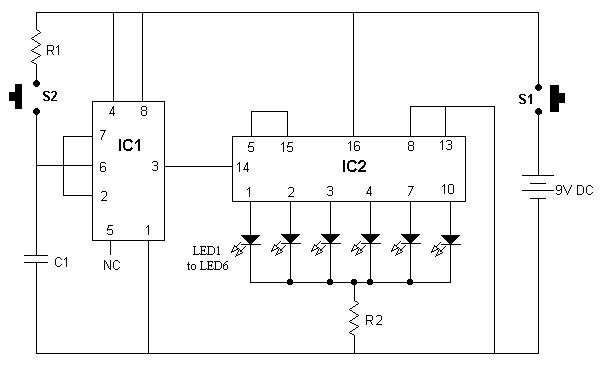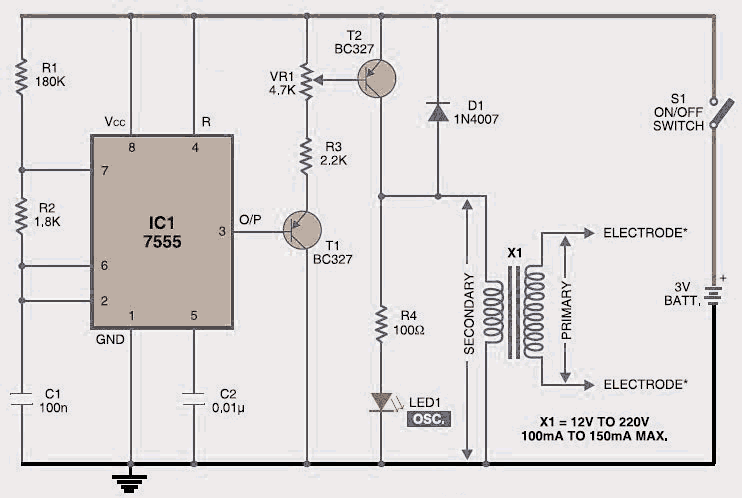
electronic dice schematics

It is advisable to enclose this circuit in a box and label each LED with numbers from 1 to 6. When switch S1 is momentarily pressed, one of the six LEDs will illuminate, with the number corresponding to the lit LED representing the output of the dice. Each time S1 is released, a different LED will light up randomly, with each LED having a 16.66% chance of glowing. This circuit utilizes two integrated circuits (ICs), namely the IC555 and the CD4017. The IC555 functions as a square wave generator, while the CD4017 acts as a counter. The CD4017 is a divide-by-10 Johnson counter with ten decoded outputs. The IC555 generates a clock signal for the CD4017, with the clock frequency determined by resistor R1 and capacitor C1. The CD4017 counter increments from 0 to 9, applying a high voltage to each of the ten pins sequentially. The high voltage transitions from one pin to the next on each positive edge of the clock signal. In this circuit, pin 5 is connected to pin 15 (reset), causing the counter to reset after reaching 6 and start again from 0. When S1 is pressed, the IC555 produces a clock signal for the CD4017, enabling it to count from 0 to 6 by applying high voltage to each of the six designated pins in sequence. These six pins are connected to the respective LEDs. Upon releasing S1, the high voltage is latched to one of the six pins, which then represents the output of the dice.
The circuit design consists of a straightforward yet effective setup to simulate a dice roll using LEDs. The IC555 timer is configured in astable mode to produce a continuous square wave output, which serves as the clock input for the CD4017 counter. The frequency of oscillation is determined by the values of R1 and C1; adjusting these components will change the speed at which the LEDs light up, thus altering the randomness of the output.
The CD4017 counter's operation is central to the functionality of the circuit. It sequentially activates its output pins based on the clock pulses received from the IC555. The reset mechanism implemented by connecting pin 5 to pin 15 ensures that the counter only cycles through the first six outputs, effectively limiting the range of the dice to the numbers 1 through 6. This is particularly important for maintaining the integrity of the dice simulation.
The momentary switch S1 initiates the counting process by sending a pulse to the IC555, which in turn generates the clock signal. The output state of the CD4017 is latched when S1 is released, allowing the circuit to display a stable output corresponding to the last activated LED. The randomness of the output is guaranteed by the nature of the clock signal, which produces a new random output each time S1 is pressed.
In summary, this circuit is an elegant solution for simulating a dice roll using basic electronic components. Its design is modular, allowing for easy adjustments and enhancements, such as incorporating additional LEDs or modifying the timing components for different output behaviors.It is good idea to put this circuit in a box and mark/write each LED with number 1 to 6. Now, when switch S1 is pushed momentarily, any one of the 6 LEDs will glow. The Number marked for glowing LED becomes dice`s output. Every time S1 is released, new LED will glow randomly. Chances for each LED to glow is 16. 66%. This circuit makes use of two IC s, IC555 and IC-CD4017. IC-555 is used as square wave generator, and IC(CD4017) as a counter. Actually CD4017 is a divide-by-10 johnson-counter with 10 decoded outputs. IC555 simply generates clock for CD4017, and the clock frequency is controlled by R1 and C1. Counter CD4017 starts counting from 0 to 9 by putting high voltage on each of the 10 pins (one after another). The High voltage shifts from one pin to another on every positive edge of the clock. Since, in our circuit pin-5 is shorted with pin-15(reset), the counter gets reset after reaching 6, and again starts from 0.
Now, when S1 is pushed, IC555 generates clock for CD4017. This clock enables CD4017 to count from 0 to 6 by putting high voltage on each of the 6 pins (one after another). These 6 pins are connected to 6 respective LEDs. When S1 is released, high voltage gets latched to any one of the 6 pins, and this becomes output of the DICE
🔗 External reference
The circuit design consists of a straightforward yet effective setup to simulate a dice roll using LEDs. The IC555 timer is configured in astable mode to produce a continuous square wave output, which serves as the clock input for the CD4017 counter. The frequency of oscillation is determined by the values of R1 and C1; adjusting these components will change the speed at which the LEDs light up, thus altering the randomness of the output.
The CD4017 counter's operation is central to the functionality of the circuit. It sequentially activates its output pins based on the clock pulses received from the IC555. The reset mechanism implemented by connecting pin 5 to pin 15 ensures that the counter only cycles through the first six outputs, effectively limiting the range of the dice to the numbers 1 through 6. This is particularly important for maintaining the integrity of the dice simulation.
The momentary switch S1 initiates the counting process by sending a pulse to the IC555, which in turn generates the clock signal. The output state of the CD4017 is latched when S1 is released, allowing the circuit to display a stable output corresponding to the last activated LED. The randomness of the output is guaranteed by the nature of the clock signal, which produces a new random output each time S1 is pressed.
In summary, this circuit is an elegant solution for simulating a dice roll using basic electronic components. Its design is modular, allowing for easy adjustments and enhancements, such as incorporating additional LEDs or modifying the timing components for different output behaviors.It is good idea to put this circuit in a box and mark/write each LED with number 1 to 6. Now, when switch S1 is pushed momentarily, any one of the 6 LEDs will glow. The Number marked for glowing LED becomes dice`s output. Every time S1 is released, new LED will glow randomly. Chances for each LED to glow is 16. 66%. This circuit makes use of two IC s, IC555 and IC-CD4017. IC-555 is used as square wave generator, and IC(CD4017) as a counter. Actually CD4017 is a divide-by-10 johnson-counter with 10 decoded outputs. IC555 simply generates clock for CD4017, and the clock frequency is controlled by R1 and C1. Counter CD4017 starts counting from 0 to 9 by putting high voltage on each of the 10 pins (one after another). The High voltage shifts from one pin to another on every positive edge of the clock. Since, in our circuit pin-5 is shorted with pin-15(reset), the counter gets reset after reaching 6, and again starts from 0.
Now, when S1 is pushed, IC555 generates clock for CD4017. This clock enables CD4017 to count from 0 to 6 by putting high voltage on each of the 6 pins (one after another). These 6 pins are connected to 6 respective LEDs. When S1 is released, high voltage gets latched to any one of the 6 pins, and this becomes output of the DICE
🔗 External reference





